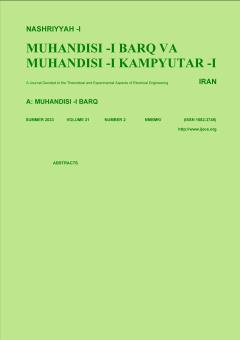Energy-saving Method in GPON Using Optimal Point Based on Gradient Descent
Subject Areas : electrical and computer engineeringAliAkbar Nikoukar 1 , Hamidreza Goudarzi 2 , ali iloon kashkooly 3
1 - Yasouj University
2 - Yasouj University
3 -
Keywords: Energy-saving, GPON, optimal point, gradient descent,
Abstract :
Doze and sleep mechanisms are the most common energy-saving solution in GPON networks. Sleep duration is the critical value in the energy-saving domain, and it will affect the QoS metrics with inappropriate value. In this paper, a new energy-saving mechanism is proposed using an optimal point based on gradient descent that calculates sleep duration and keeps QoS metrics acceptable. The historical value of average delay and packet, drop ratio, ONU buffer, and bandwidth request parameters are used as input, and the sleep duration value is calculated. The simulation results show that the proposed method saves up to 17% energy in GPON and keeps the network’s QoS in an acceptable domain.
[1] Cisco, Cisco Annual Internet Report (2018–2023), https://www.cisco.com/c/en/us/solutions/collateral/executive-perspectives/annual-internet-report/white-paper-c11-741490.pdf, Accessed on 22 May 2022.
[2] E. Gelenbe, Energy Consumption by ICT and Cybersecurity at the Time of COP26, 9 Nov. 2012, https://iotac.eu/energy-consumption-by-ict-and-cybersecurity-at-the-time-of-cop26/
[3] S. S. Newaz, M. S. Jang, F. Y. M. Alaelddin, G. M. Lee, and J. K. Choi, "Building an energy-efficient uplink and downlink delay aware TDM-PON system," Optical Fiber Technology, vol. 29, pp. 34-52, May 2016.
[4] T. Thangappan, B. Therese, A. Suvarnamma, and G. S. Swapna, "Review on dynamic bandwidth allocation of GPON and EPON," J. of Electronic Science and Technology, vol. 18, no. 4, pp. 297-307, Dec. 2020.
[5] R. Bonk, et al., "50G-PON: the first ITU-T higher-speed PON system," IEEE Communications Magazine, vol. 60, no. 3, pp. 48-54, Mar. 2022.
[6] I. Dias, L. Ruan, C. Ranaweera, and E. Wong, "From 5G to beyond: passive optical network and multi-access edge computing integration for latency-sensitive applications," Optical Fiber Technology, vol. 75, Article ID: 103191, 9 pp., Jan. 2023.
[7] A. A. Shabaneh and M. L. Melhem, "Execution simulation design of fiber-to-thehome (FTTH) device ingress networks using GPON with FBG based on optisystem," International J. of Electronics and Telecommunications, vol. 68, no. 4, pp. 783-791, 2022.
[8] A. Tomasov, M. Holik, V. Oujezsky, T. Horvath, and P. Munster, "GPON PLOAMd message analysis using supervised neural networks," Applied Sciences , vol. 10, no. 22, Article ID: 10228139, 12 pp., 2020.
[9] B. R. Rayapati and N. Rangaswamy, "Adaptive scheduling mechanism with variable bit rate traffic in EPON," J. of Optical Communications, vol. 43, no. 2, pp. 235-240, 2022.
[10] International Telecommunication Union, G.984.3: Gigabit-Capable Passive Optical Networks (G-PON): Transmission Convergence Layer Specification, http://www.itu.int/rec/T‑REC‑G.984.3/en, Accessed on 22 May 2022.
[11] M. SafaeiSisakht, A. Nikoukar, H. Goudarzi, I. S. Hwang, and A. Tanny Liem, "Lattice based EPON energy-saving scheme analysis," Optical Fiber Technology, vol. 57, Article ID: 102243, Jul. 2020.
[12] C. Z. Yang, et al., "Enhancing energy efficiency of the doze mode mechanism in ethernet passive optical networks using support vector regression," Photonics, vol. 9, no. 3, Article ID: 9030180, 2022.
[13] S. Dutta, D. Roy, and G. Das, "Protocol design for energy efficient OLT in TWDM-EPON supporting diverse delay bounds," IEEE Trans. on Green Communications and Networking, vol. 5, no. 3, pp. 1438-1450, Sept. 2021.
[14] Y. Lv, M. Bi, Y. Zhai, H. Chi, and Y. Wang, "Study on the solutions to heterogeneous onu propagation delays for energy-efficient and low-latency EPONs," IEEE Access, vol. 8, pp. 193665-193680, 2020.
[15] S. Dutta and G. Das, "Design of energy-efficient EPON: a novel protocol proposal and its performance analysis," IEEE Trans. on Green Communications and Networking, vol. 3, no. 3, pp. 840-852, Sept. 2019.
[16] M. Lotfolahi, C. Z. Yang, I. S. Hwang, A. Nikoukar, and Y. H. Wu, "A predictive logistic regression based doze mode energy-efficiency mechanism in EPON," IEICE Trans. on Information and Systems, vol. E101D, no. 3, pp. 678-684, Mar. 2018.
[17] S. Dutta, D. Roy, and G. Das, "SLA-aware protocol design for energy-efficient OLT transmitter in TWDM-EPON," IEEE Trans. on Green Communications and Networking, vol. 5, no. 4, pp. 1961-1973, Dec. 2021.
[18] M. Zhu, J. Gu, and G. Li, "PWC-PON: an energy-efficient low-latency DBA scheme for time division multiplexed passive optical networks," IEEE Access, vol. 8, pp. 206848-206865, 2020.
[19] I. S. Hwang, A. Nikoukar, Y. M. Su, and A. T. Liem, "Decentralized SIEPON-based ONU-initiated Tx/TRx energy-efficiency mechanism in EPON," J. of Optical Communications and Networking, vol. 8, no. 4, pp. 238-248, Apr. 2016.
[20] International Telecommunication Union, G.Sup45 (09/2022): Power Conservation in Optical Access Systems, Available at https://handle.itu.int/11.1002/1000/15223, Accessed on 22 Oct 2022.
[21] S. S. Lee and K. Y. Li, "Adaptive state transition control for energy-efficient gigabit-capable passive optical networks," Photonic Network Communications, vol. 30, no. 1, pp. 71-84, 2015.
[22] K. A. Memon, et al., "Dynamic bandwidth allocation algorithm with demand forecasting mechanism for bandwidth allocations in 10-gigabit-capable passive optical network," Optik, vol. 183, pp. 1032-1042, Apr. 2019.
[23] A. Dixit, et al., "Dynamic bandwidth allocation with SLA awareness for QoS in ethernet passive optical networks," IEEE/OSA J. of Optical Communications and Networking, vol. 5, no. 3, pp. 240-253, Mar. 2013.
[24] D. Roy, S. Dutta, A. Datta, and G. Das, "A cost effective architecture and throughput efficient dynamic bandwidth allocation protocol for fog computing over EPON," IEEE Trans. on Green Communications and Networking, vol. 4, no. 4, pp. 998-1009, Dec. 2020.
[25] J. Lee, I. Hwang, A. Nikoukar, and A. T. Liem, "Comprehensive performance assessment of bipartition upstream bandwidth assignment schemes in GPON," J. of Optical Communications and Networking, vol. 5, no. 11, pp. 1285-1295, Nov. 2013.
[26] A. R. Dhaini, P. H. Ho, and G. Shen, "Toward green next-generation passive optical networks," IEEE Communications Magazine, vol. 49, no. 11, pp. 94-101, Nov. 2011.


